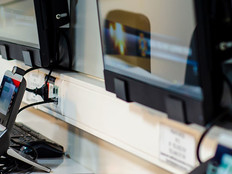Multiple connected police cars can form a network hub, making it easier to automatically share data. This capability boosts situational awareness and enables officers to focus more on the job at hand and their engagements with their teams and the public instead of constantly sending updates via radio.
Connected cars can also synchronize with one another, so sirens and flashing lights form a rhythm that’s less distracting for civilian drivers. Likewise, a critical component of these connected vehicles is the ability to remotely control features, such as lights and cameras, which can be crucial when responding to high-stakes incidents.
Similarly, connected ambulances are paving the way toward more efficient and informed remote patient care. Mobile IoT devices will help paramedics streamline data capture and transmit findings to hospitals in real time, so emergency rooms can prepare for incoming patients.
RELATED: How can connected fleet solutions help first responders communicate more effectively?
Connecting to a remote patient monitoring platform can even help ER doctors detect potential complications before they occur. In addition to collaborating with the ER, enhanced video streaming will provide emergency medical services (EMS) teams with real-time footage of incidents so they can best strategize their action plans and resource allocation.
As connected cities develop further, technology advancements will support more real-time collaboration among emergency response professionals.
This works across functions too. For example, police cars will be able to interact with one another and connect with fire trucks, ambulances and utility vehicles as well. This type of coordination will be key for powering efficient and coordinated responses in times of need.
MORE FROM STATETECH: Discover how better data enhances emergency response.
Advanced Technology Can Improve Emergency Response
As connected cities develop, a key part of their success will be their ability to streamline the use of advanced technologies. While some agencies are already leveraging solutions such as drones, GPS, augmented and virtual reality, and thermal imaging, the connectedness of smart cities will lead to much more efficient data sharing.
Drones have a variety of applications across the public sector. One of their most important use cases is for fire departments monitoring wildfires. Firefighters can survey the situation remotely via drones rather than sending crew members out to a potentially dangerous scene. This visibility is also helpful when coordinating responses, as they can determine the number of crews needed in advance. Police agencies can also benefit from the ability to monitor scenes remotely when conducting crowd control.
On the EMS front, the enhanced connectivity that will power ambulances will also support the use of augmented and virtual reality. These tools will enable ER doctors to walk paramedics through procedures so they can deliver the urgent critical care needed from the field in time-sensitive situations.
GPS and thermal imaging technologies are becoming more widespread for disaster cleanup and rescue missions. Pairing GPS and 3D modeling software on a mobile device can help public sector professionals pinpoint the exact location of an individual in distress or help identify displaced household objects. Forward-looking infrared (FLIR) cameras can operate in a similar way, detecting the heat radiating off an area to help first responders locate individuals who need support.
DIVE DEEPER: How can the Internet of Things and analytics enhance disaster response?
Public Safety Agencies Can Leverage Enhanced Wireless Connectivity
In order for the capabilities of connected cities to meet their full potential for public sector agencies, a few technology developments will be crucial.
First, LTE and 5G will need to become more widespread and consistent. Statista estimates that data use will grow so significantly by 2022 that 5G will be necessary to support the increased strain on 4G.
For public sector agencies to best prepare for this transition, it will be important to map out the use cases they’ll plan to leverage so they can identify the appropriate supportive technology for these connected city environments.
Likewise, as these advancements bring about the collection of unprecedented amounts of digitally captured data, analytics and automated solutions will be critical to help interpret and make use of findings. Data only becomes intelligence when it’s in a usable format. The right tools can help ensure that data collection is mission-specific to efficiently determine what is actionable.
LEARN MORE: How will 5G enable new Internet of Things capabilities for smart cities?
Redefining the Objectives of First Responders
As we look toward this future of efficient emergency response, we’re bound to see a shift in the objectives of first responders.
Before, the goal of dispatchers was to make sure responders arrived at the right places, but the data offered by new technologies is enabling them to provide better insights on situations. This background helps responders with resource planning and supports a more efficient response.
Ultimately, the development of connected cities will enable first responders to arrive better prepared to incidents, deliver more coordinated and effective service, and ensure a smoother transition to the next point of care.











